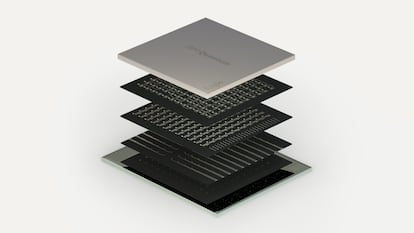IBM unveils the Eagle, the quantum processor set to revolutionize computing
The chip from the US company is the most powerful to date, but translating the new technology into widespread daily use will take time


The development of quantum computing is set to revolutionize computing as we know it, by exponentially increasing processing power. The latest advance in the field has come from IBM, which unveiled the Eagle processor this week. Boasting 127 qubits (quantum bits) of quantum power, it doubles the power of China’s Zuchongzhi processor, previously the world’s most advanced.
How powerful is that? IBM’s Eagle processor has the capacity to smash the record set by the Zuchonhzhi processor created by engineers at China’s University of Science and Technology and Tsinghua University in Beijing, which managed in three minutes to solve a problem of random number generation that would have taken other supercomputers 600 million years. The IBM processor is “a key milestone on the path towards practical quantum computation,” said Zaira Nazario, technical manager of Quantum Computing Theory and Applications at the US company, in a video call.
The new quantum processor breaks the previous barrier of 100 qubits, the most basic units of information in a quantum computer. To give an idea of scale, the number of bits (a one or a zero in a normal computer) needed to match the computing power of the 127-qubit processor would exceed the total number of atoms in the more than 7.5 billion people alive today, according to IBM.
The breakthrough is significant, but we are still a long way from quantum computers taking computing to new heights in our daily lives. For that to happen, their power will need to be around one million qubits. “The arrival of the Eagle processor is a major step towards the day when quantum computers can outperform classical computers for useful applications,” said Spain’s Darío Gil, IBM’s vice president and director of research, in a statement. The technology company aims to have a new 433-qubit processor ready next year, and a 1,121-qubit processor by 2023.

IBM and Google are vying to produce the first quantum computer for commercial use, though companies such as Microsoft and Intel are also in the race. On a geopolitical level, the main players are the US and China, with Europe as an observer. When it comes to R&D investment, China’s spending is unrivaled: between 2017 and 2020 it invested $10 billion (€8.9 billion) in quantum computing programs at its research centers. The US has set aside $1.2 billion (€1.06 billion) until 2023, while the EU will assign $1 billion (€890 million) until 2026.
Theoretical physics turned reality
As its name suggests, quantum computing borrows from quantum physics – the study of matter at subatomic levels – to offer the possibility of vastly increased computing power. Conventional computers work with the binary system of the digits 0 and 1. These 0s and 1s, or bits, are translated in the physical world into small electrical currents that are produced in transistors. In a state-of-the-art microchip, there are billions of transistors, capable of performing complex operations in seconds. But no matter how small they get, there will come a time when no more transistors can be crammed onto a single chip.
Quantum computing breaks down these physical barriers because quantum bits, or qubits, can be both 0 or 1 at the same time, a concept known as superposition, or existing in multiple states at once. When multiple qubits are combined, in a process known as entanglement, their computing capacity becomes exponentially greater. With two qubits, four operations can be performed; with 10, 1,024, and so on.
The development of the infrastructure needed to host and exploit qubits is extremely complex. Engineers have had to deal with problems such as cooling the processor (qubits need to operate at temperatures close to absolute zero, or -273 degrees Celsius) and in total isolation, as any vibration (such as noise) can destabilize them.
It is difficult to know how far these new computers will go once they are perfected. For the time being, they are expected to significantly boost research into new materials, drug development, the exploration of the universe, and will solve problems related to machine learning, the most promising artificial intelligence technique of our times.
One downside: the encryption in use for digital security today will become vulnerable when quantum computing reaches a certain state of maturity. IBM has recognized the “responsibility” it has to mitigate the risks it is introducing into the digital world. Companies and individuals will have to opt for new data security measures in the future that quantum computing cannot breach.
Tu suscripción se está usando en otro dispositivo
¿Quieres añadir otro usuario a tu suscripción?
Si continúas leyendo en este dispositivo, no se podrá leer en el otro.
FlechaTu suscripción se está usando en otro dispositivo y solo puedes acceder a EL PAÍS desde un dispositivo a la vez.
Si quieres compartir tu cuenta, cambia tu suscripción a la modalidad Premium, así podrás añadir otro usuario. Cada uno accederá con su propia cuenta de email, lo que os permitirá personalizar vuestra experiencia en EL PAÍS.
¿Tienes una suscripción de empresa? Accede aquí para contratar más cuentas.
En el caso de no saber quién está usando tu cuenta, te recomendamos cambiar tu contraseña aquí.
Si decides continuar compartiendo tu cuenta, este mensaje se mostrará en tu dispositivo y en el de la otra persona que está usando tu cuenta de forma indefinida, afectando a tu experiencia de lectura. Puedes consultar aquí los términos y condiciones de la suscripción digital.










































